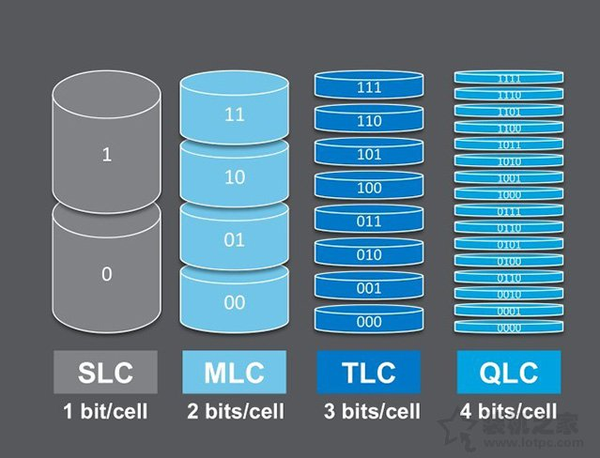SLC (Single Level Cell)
MLC (Multi-Level Cell)
TLC (Trinary-Level Cell)
QLC (Quad-Level Cell)
The smallest unit for storing data is called "Cell". Each cell of SLC can store 1 bit of data, each cell of MLC can store 2 bits of data, each cell of TLC can store 3 bits of data, and QLC can store 4 bits of data.

The secret of flash memory lifespan is hidden in these different level of cells, the single-level cell sounds not good compared with the quad-level cell of particles, is it true?
Comparison of QLC, SLC, MLC, TLC particles
The full name of SLC is Single-Level Cell, single-level electronic structure, each cell can store 1 bit data, SLC reaches 1 bit/cell, the voltage change interval is small when writing data, and the P/E life is longer. The theoretical number of erasing and writing is over 100,000, but due to the highest cost, SLC particles are mostly used for enterprises as high-end products.
The full name of MLC is Multi-Level Cell, which uses high and low voltage and differently constructed multiple level electronic structures. MLC reaches 2 bit/cell, P/E has a long life, and the theoretical erasing and writing times are about 3000-5000 times. The cost is relatively high, but it is also acceptable for the consumers, mostly used in high-end household products.
The full name of TLC is Trinary-Level Cell, which is an extension of MLC flash memory. TLC reaches 3 bit/cell. Due to the higher storage density, the capacity is theoretically 1.5 times that of MLC, and the cost is lower. But the P/E life is relatively lower, and the theoretical erasing and writing times range from 1000 to 3000, which is the mainstream flash memory on the market.
The full name of QLC is Quad-Level Cell. QLC flash memory particles have a higher storage density than TLC, and at the same time, the cost is lower than TLC. The advantage is that the capacity can be made larger. The cost is much lower, yet the disadvantage is that the P/E life is shorter, and the theoretical number of erasing and writing is only 150 times.
|
SLC |
eMLC |
MLC |
TLC |
|
|
Bit/cell |
1 |
2 |
2 |
3 |
|
Max.write/read (PE) times |
100,000 |
30,000 |
10,000 |
5,000 |
|
Endurance |
Amazing |
Great |
Good |
OK |
|
Cost |
$$$$$ |
$$$$ |
$$$ |
$$ |
|
Applications |
Enterprises |
Enterprises |
Tech Fancier/ Consumers |
Consumers |
